SW Polo Roundtable With Jen Dubow, John Abdou & Dan Sharadin On Biggest Issues Facing The Sport
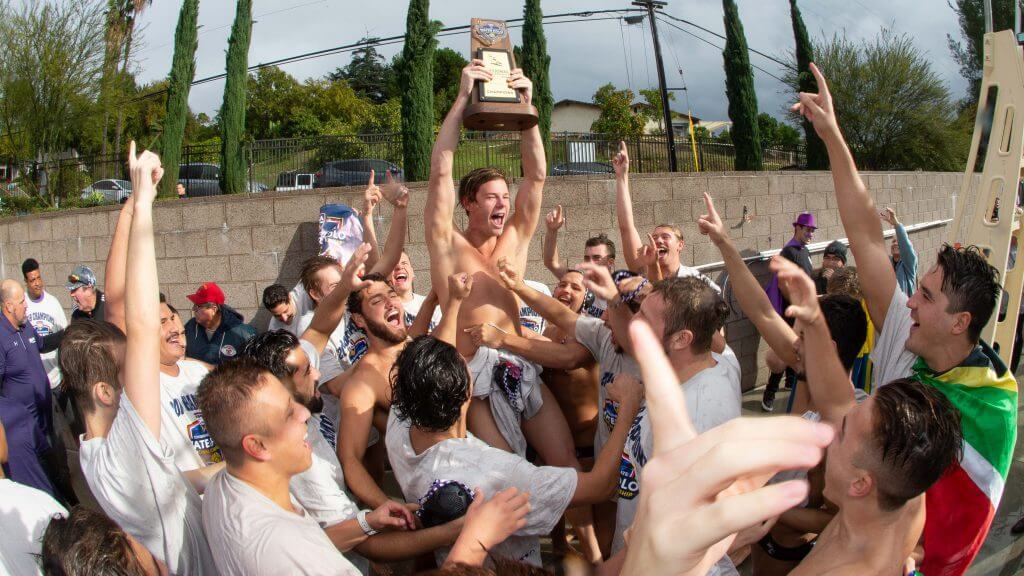
WHITTIER, CA. It was, as seminal moments in recent American water polo history go, not the most noteworthy backdrop. A media room on the Whittier College campus is where three of the most important decision-makers in NCAA varsity water polo explained a shared goal that came to fruition last weekend: the first-ever national DIII men’s water polo championship.
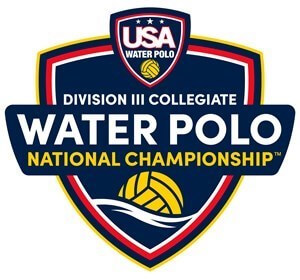
Gathered around a table were Jen Dubow, Commissioner for the Southern California Intercollegiate Athletic Conference (SCIAC); John Abdou, Chief High Performance Officer for USA Water Polo, who is also the Executive Director for the Association of Collegiate Water Polo Coaches (ACWPC); and Dan Sharadin, Commissioner of the Collegiate Water Polo Association. Each brought a particular talent and role to creating the inaugural Men’s Collegiate National Water Polo Championship. Abdou provided crucial funding, courtesy of the national governing body for the sport in America. Dubow oversees the strongest collection of polo-playing schools in Division III athletics. And Sharadin brought an incomparable depth of experience as well as oversight over virtually all varsity polo East of the Mississippi.
That this men’s tournament — and an associated championship for DIII women that will take place next year — exists, is a credit to the tenacity of these three individuals, as well as many others. It’s also an indicator of a continued groundswell of growth for polo in America, which all who care about the sport will surely celebrate.
– What was it that sparked the collaboration that resulted in the first-ever DIII national championship?
Dan Sharadin: The initiative has been there [for years]. Changes that made the difference were these two [Dubow and Abdou]. We tried a couple of different times for a self-funded divisional championship. It broke down primarily because the SCIAC is set up very differently than the CWPA.
CWPA teams are accustomed to large travel budgets, and many of them have to fly to games. For example, the women’s [division] spans from Macalester in Minnesota to Connecticut College in New London. On the men’s side [it’s from Boston] all the way down to Baltimore. The idea of large distances to travel for a championship is not an issue.

From left to right: Dan Sharadin, Jen Dubow and John Abdou with interviewer Michael Randazzo. Photo Courtesy: Tony Leon
The SCIAC, on the other hand, plays within driving distance for weeknight games. The self-funded championship broke down because the SCIAC teams were unable to handle the additional budget required to fly East each year. It was on the women’s side for a couple of years, but when the West Coast had to put in their budget to come East to play for that event it fell apart.
We tried a couple of different models, they just never got any traction. When John was able to create the funding platform and Jen was able to get the buy-in from the SCIAC membership, it all fell into place.
Jen Dubow: That was [before] my time here. When I came in, USA Water Polo had already been in the conversation about being the primary sponsor. I was hired in March 2016; I think we’ve been on calls and been trying to do this ever since.
Sharadin: John was the next linchpin.
Dubow: And John Benedict [former senior associate AD and water polo/swim & dive coach at MIT]. I want to make sure we mention him. He was a driving force, and a lot of my education about what we were trying to do came from him. For me, coming from DIII in the East and not being familiar with how water polo was structured, it was a process for us to go through and see if it made sense for us to commit to.
That’s why it took two years. We ran it through our governance structure. Our coaches gave us feedback, our athletic directors talked about it. I brought it to my faculty athletic reps and ultimately it was a presidential vote in our league to step away from the NCAA collegiate tournament and make sure we are committed to this.
Because what we weren’t going to do is, is say [that] Whittier is going to the NCAA collegiate tournament and our next two teams are going to participate in [the DIII tournament]. If we were going to be in it, we were in it.
That’s how strongly we believed that it needed to have our full support as the lone Division III water polo conference.
– USA Water Polo is the national governing body for polo. Was it unusual for them to influence growth on the collegiate side?
Abdou: It’s important to note that the genesis of this started long before I was involved at USA Water Polo. These conversations have been happening for decades. Dan, John Benedict, guys like Mike Sutton at Claremont. He recruited me as an athlete. I’ve known him for a long time.
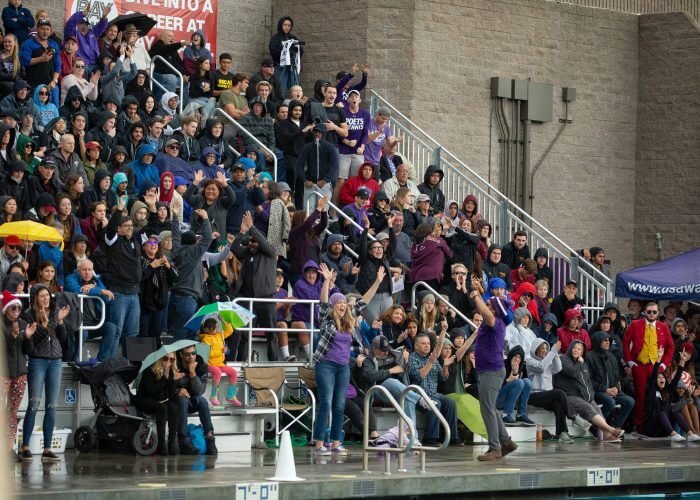
The DIII final was a hit with the fans. Photo Courtesy: Tony Leon
The fourth party that I represent as well is the Association of Collegiate Water Polo Coaches, which I serve as the executive director. The common connector for all the colleges is within that group of coaches at the ACWPC. A priority within that group was: how do we really make this happen?
Everybody’s wanted this for decades. But. there’s two roadblocks; the number one is always funding. In my role at USA Water Polo, I carved that out immediately. I had the money five years ago.
The more challenging thing to overcome is somehow finding an alliance of university presidents, athletic directors, coaches and conference commissioners. That’s where the puzzle piece comes in. Because I think when there’s a will, there’s a way in the sense of the water polo community.
If it wasn’t USA Water Polo that was going to fund this thing then ACWPC was going to put their money in. There’s individual donors that are really passionate about this. The hard part — and this is why I give a lot of credit to Jen, Dan and the John Benedicts and Mike Suttons — is getting universities to buy in and then have a conference say: “We’re not going to use our NCAA [automatic qualifier]” and have coaches and ADs be okay with this.
That’s a challenge. That’s what took three years and is what got us over the hump.
To answer directly about US Water Polo, for us, when you grow the ecosystem, the sport grows. That’s just common sense. We need a large ecosystem of water polo in America and a lot of people playing polo at all levels. Eventually, that’s going to help the base.
When we see a new DIII program open up in Iowa or Ohio or Texas, and a coach moves out there and then they start a club and then they hire an assistant coach and they lay roots in these areas, it’s exciting to see how much water pole will grow.
– What about the obstacles that the SCIAC faced? You had to overcome potential resistance from all your water polo coaches by forgoing the NCAA tournament.
Dubow: I give a lot of credit to the athletic directors at each [SCIAC] institution. They’re strong believers in the Division III philosophy. For us, once that financial hurdle was taken care of, it allowed us to say: “What’s in the best interest of our student athletes and how can we provide them with the best opportunity and experience in a national tournament?”
And, it’s exciting when we win. Chapman won the DIII baseball national championship last year. Pomona-Pitzer’s cross country [team] won the men’s national championship this year. We’re not just looking to win a round — we have pretty lofty goals. When our schools go to the DIII national championship, our goal is to win.
Yes, we knew maybe there would be some initial struggles explaining to the coaches why this year it’s different, but the thinking is where we’re going to be in three, four, five, six years. I give them credit to be able to get behind this. It wasn’t as difficult with the athletic administrators — on each campus they’re the voice to the presidents, to the faculty, to their coaches, to their student athletes.
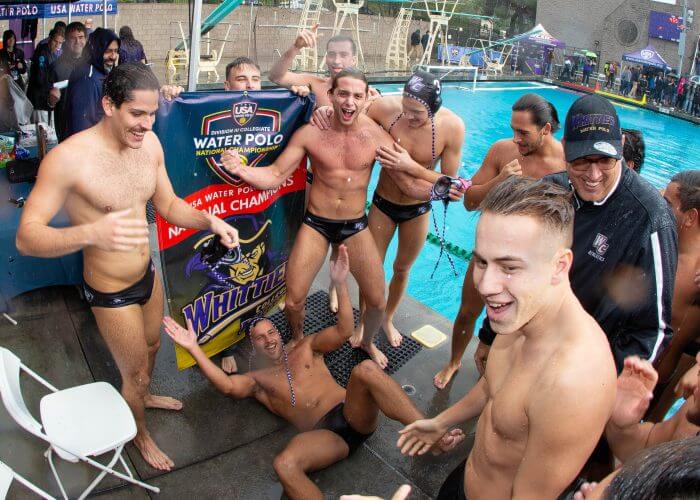
The level of excitement was palpable. Photo Courtesy: Tony Leon
I needed to make sure I went through the right governance structure and get the feedback and say: “Yes, we would be leaving our NCAA AQ and we need to think about the pros and the cons?” And, would we negatively impact the DI and D2II water polo? Because we’re going to think about that. We don’t want to put ourselves forward if it takes them back.
It wasn’t just going to be a decision that I made. I needed to lay everything out.
– Dan, how were you able to get buy in from MIT or Hopkins or, let’s say, a Connecticut College that they might have to give up their conference title.
Sharadin: There’s a different factor with our conference because men and women do things differently. The DIII and [DI] women are each their own division. They only play against each other and they qualify through a championship for their winner.
The men are involved in three different conferences and geographically, it was not within their budget for MIT and Hopkins to continue their programs if it meant that they had to fly to Minnesota or Erie or wherever they’d have to go to and combine an all-men’s division. Basically, there had to be a way for those teams to maintain their own geographic participation. MIT’s in the Northeast Conference and Hopkins is in the Mid-Atlantic East. If they had to leave those conferences to join a DIII, I don’t think their institutions would have been willing to sponsor the sport.
What would we do with those teams if they won [their conferences]? The NCAA has a rule that says that if you win your division and you are part of an AQ conference and you turn down your bid, then your team or your conference can lose its AQ. That meant that if MIT won in the Northeast or Hopkins in the Mid-Atlantic East, they would have to go to the NCAA DI tournament or that the conference would lose their AQ.
[On The Record With Whittier’s David Kasa, Head Coach of the DIII Men’s Polo National Champs]
On the women’s side, it was easy. We just had to move the women’s qualifier and they become part of this process.
– That’s a pretty severe penalty for the men, and it’s interesting this never came up in public.
Sharadin: Coaches said: “We’re not in favor of this. If MIT wins this and they’re part of our conference and they’re going to kill our AQ and we’re not happy about that.” To get everybody on the same page was a sensitive issue. We had to come up with an alternative and the SCIAC — to their credit — was willing to bend on this and agree.
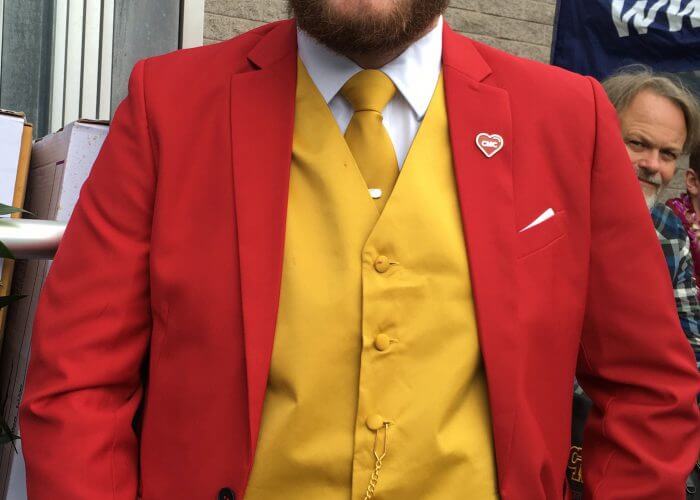
Not everyone was happy with the outcome. Photo Courtesy: M. Randazzo
While it’s unlikely that [MIT and Johns Hopkins] would win, because they’ve never done it before, there would be an exception made.If they did win at that particular year, they would go to the D1 to help maintain that conference and then the next best representative from [their conference] would go.
Did I think that’s going to happen? Like I said, it’s never been done in the past.
But something had to be laid out that made it possible. And those discussions took time. People have a knee-jerk reaction sometimes. So, you have to educate them. You get all the parties on the same page. That was our biggest obstacle.
– How much was predicated on an attitude that the sport is growing? Or, was there any uncertainty about the sport’s future?
Sharadin: It’s definitely growing. In the last four years, we’ve added 12 new programs. The issue is: if you’re an institution, your first requirement is to take care of your own group. So, you have competing interests. There are times where an institution’s best interests are not necessarily what we’re trying to accomplish with the group as a whole.
That requires a lot of discussion. And in the end, you have to find a point where the best interest of the institutions can still be met with a common goal. Those are the challenges. And that’s not always easy.
– Just as an aside, there will be a women’s DIII national championship next May?
Sharadin: Five months from now.
Dubow: It’s May 8-10.
– Jen, from your perspective, what is going to be the criteria two, three, four years down the line to say: “We went out on a limb on this and this is why this was a great decision and why we will continue to do this.”
Dubow: I think there’s two. I think there’s the definition of success right now and then the definition of success of what we want to see each year.
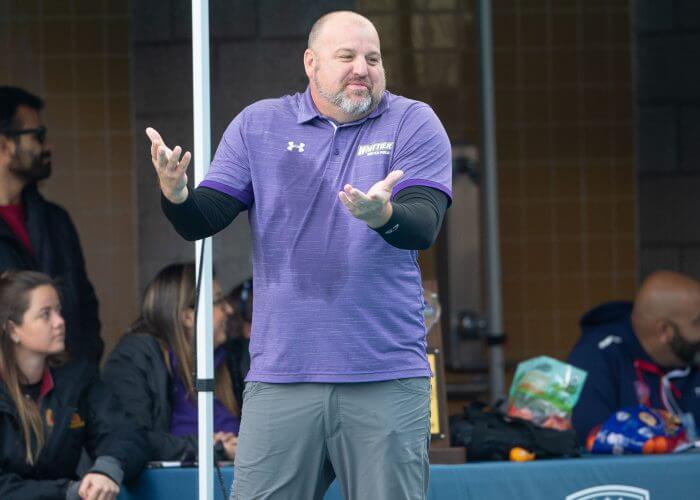
Whittier’s David Kasa. Photo Courtesy: Tony Leon
I spoke with the SCIAC coaches [David Kasa for Whittier and Greg Lonzo for CMS] and some of the other coaches that just did the clinic [Sunday before the third-place match] and from everything that I’ve heard, it’s been a great.
Even though we do have the matchup of MIT and Johns Hopkins [for third] and the two SCIAC teams [in the final] — trust me, I know Whittier and Claremont are going to be very fired up to play each other. So, short term is making sure that the experience is exceptional for the student athletes that are here.
Long-term success is seeing programs added. That’s what we want. We have a five-year commitment from USA Water Polo and at the end of that I hope it’s an NCAA [-sponsored tournament]. We have to get to 40 on the women’s side and 50 on the men’s side.
We’re not reinventing the wheel here. Men’s volleyball did this; they were a collegiate sport and the ball company [Molten] agreed to sponsor a DIII national championship similar to this. They broke off in 2012 and by 2019 there are 113 colleges that have men’s volleyball.
– From 2012 to 2019 they grew from…
Dubow: 20, 3o to more than 100 — and a It’s a 14-team tournament this year.
Sharadin: Didn’t it go all the way back to 1997?
Dubow: That could have been when the Molten-sponsored collegiate championships started. I remember being new in the commissioner’s room — and the one commissioner behind it [spoke at] every meeting I went to.
Abdou: It’s important to note that the association of collegiate volleyball coaches — and Kathy DeBoer, the executive director of the coach association — was a big part of pushing for [the tournament] and connecting to a sponsor.
It’s an alliance of power brokers in the sport that got together to do it for volleyball. And that was the inspiration, along with the history there. This was the model. And then we followed the model of, okay, that worked. Hopefully it keeps going.
– I think it’s clear where USA Water Polo sits with this; raw growth at any level is the success. I realize now you have a dual role. Given your connection to the coaches’ association, does it sometimes distract from USAWP’s primary mission?
Abdou: We’re all interested in growth, period. I’m carrying tables. I’m folding chairs, I ran the clinic this morning. To say that we’re above any granular planning or any granular detail of this, we’re not. We’re going to pull our bootstraps up and do whatever it takes to grow the sport nationwide and anything that we can do, we’re going to do.
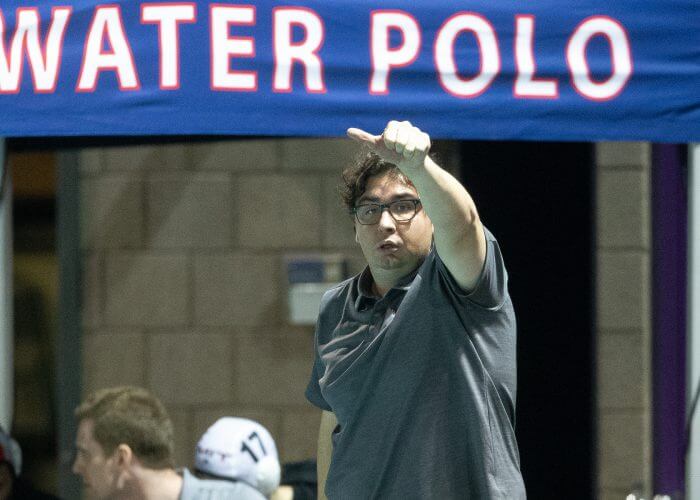
MIT’s Austin Ringheim, a Whittier alum. Photo Courtesy: Tony Leon
A great measurement of success with this goes back to the question of what success is, if you saw the 30+ kids in the water this morning. They got to directly connect with college coaches at the DIII level — and they’re smiling ear to ear and their parents are smiling ear to ear. They know their youth participation in the sport, the sport that their kids played since they were 10, 11, 12 years old is leading to them and getting a great college education at a wonderful institution.
That’s going to pay off in the long run. And that’s what we want to see. Jen mentioned the student athlete experience. They’re going to get a student athlete experience that’s exceptional because they love water polo and we’re here feeling that passion.
– Dan, there already is a fantastic collection of teams growing under the CWPA’s initiative, which is the club scene. Are these connected to this new initiative? Might 10, 15, 20 club programs be are incentivized to join DIII?
Sharadin: I certainly think there’s linkage between getting a club started and moving to varsity level. Certainly, there’s schools that go right to varsity. But a common question is, “Well what kind of interest is there on campus for us to do this?”
If you have a proven club model already in existence, it makes the process easier. That’s the situation that Augustana [College] is looking at. They’re coming on board [for DIII]. They had a club program and their AD said, “Well we already have it, let’s move forward to varsity.”
Clearly, we just want to see more kids playing. More kids playing means more varsity teams [and] the infrastructure builds from there.
– You’ve been the commissioner of the CWPA since 1990, What’s your view of success for the sport you’ve been devoted to for so long?
Sharadin: Certainly, a DIII NCAA championship. Then, as soon as that happens, we look to DII. That’s where it’s at.



